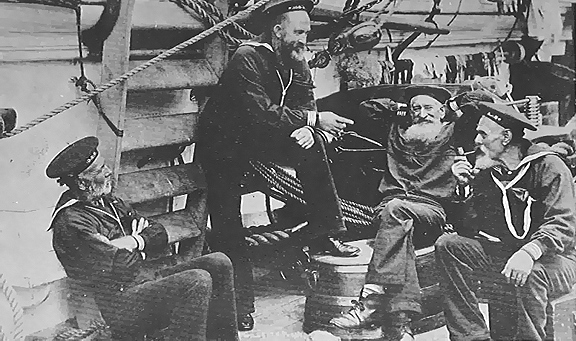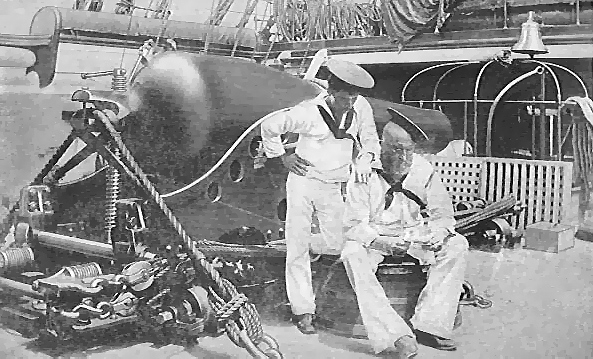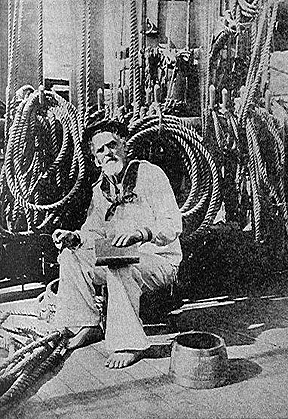|
|
|||
The Old Navy |
|||
|
|
|||
| Webmaster's Note: | |||
While this may seem out of character for "TenderTale" - it's really not. Within a few years of these photos being taken - men like these - serving aboard this very ship - became some of the earliest submarine tender sailors. While there is a strong contrast between the sailing ships of "The Old Navy" with that of submarines and tenders of "the modern Navy"; that contrast is one of technology and machines. The sailors of "The Navy" remain a constant thread of duty, loyalty and honorable service - then and now. These men, then - are representative of those that started the submarine tending thread - while the men and women serving their country today in Guam and La Maddalena, Italy are continuing to weave that long thread. |
|||
|
|
|||

| |||
| "The Old Navy" Taken aboard U. S. S. Mohican in 1888 |
|||
|
|
|||
| Click here to read the poem "THE OLD OUTFIT" by a World War II Sailor... | |||
|
|
|||
|
U N I T E D S T A T E S N A V A L I N S T I T U T E |
|||
| PROCEEDINGS | |||
|
|
|||
|
|||
|
|
|||
|
[Copyrighted] ______________ THE OLD NAVY By Captain J. K. Taussig, U. S. Navy ________________ |
|||
|
The famous picture known as "The Old Navy," reproduced herewith, was taken on board U.S.S. Mohican in 1888. The photographer was Assistant Surgeon H. W. Whitaker, U.S. Navy. When Captain J. R. Y. Blakely and the writer were on duty in the Bureau of Navigation in 1913, the former had the happy thought that it would be of interest to ascertain the identity of the characters in the picture. Under his initiative, the two of us proceeded to gather what information was to be obtained from the Bureau's records, and from other sources. A visitor to the Bureau, rear Admiral George C. Reiter, informed us that the picture was taken on board the Mohican, he thought in 1886. This gave a clew for starting the research. On looking up the Navy Register for 1886 it was found that several officers conveniently near to Washington were on board the Mohican at that time. Among these officers are the present Rear Admirals R. F. Nicholson and E. W. Eberle, and Captain R. L. Russell. Captain Blakely sent a copy of the photograph to these three officers, and also to Chief Boatswain's Mate George A. Dueland and Chief Quartermaster Lars P. Jonsson, both retired, who were on the Mohican during this cruise. The replies received from these officers and men were not only interesting, but gave sufficient information so that, with a study of the muster rolls and descriptive lists, a positive identification of the four men could be made. There had been no question as to three of them, but there was a difference of opinion in regard to the old white bearded sailor with his hands behind his head. Some thought he was John Ward, armorer; some thought he was old Norman; others said he was "Old Griff." These latter were correct, as he was finally unquestionably identified from the muster rolls and descriptive lists as John T. Griffith, Chief Carpenter's Mate. The reason for the difficulty in the identity of this man was due to the supposition that the picture was taken in 1886, while it turned out that it was actually taken in 1888. Griffith was not transferred to the Mohican until the latter date, and was on board for only a month. Some of the officers who were on board in 1886 when the other three men were also there, were transferred to other vessels before Griffith arrived on the Mohican. The four men, with a brief transcript of their services, are: 1. GILBERT H. PURDY, who is standing addressing the others. Purdy was born in 1828, and therefore was 60 years old when the picture was taken. He was a physically powerful man and was remarkably well preserved, as is shown by the photograph. He died December 24, 1912, at San Diego, California, at the age of 84, being at the time of his death the oldest man on the retired list of the navy. | |||
 | |||
| The men behind the guns - U.S.S. Mohican, 1888 Gilbert H. Purdy, Captain of the Hold" | |||
|
During the Civil War he served as sergeant in Battery K, 4th U. S. Artillery, and as a seaman on board several naval vessels. He also had the honor of serving under Admiral Dewey on the Olympia during the Spanish-American War. He was transferred to the retired list on February 7, 1900. Purdy served as captain of the hold on board the Mohican from May 25, 1885, to August 28, 1888. 2. DAVID IRELAND, seated with arms folded. Ireland was born in 1833, and was therefore 55 years old when the picture was taken. He first enlisted in the Navy on April 8 1850, so he had seen 38 years of service when on the Mohican. He served on many ships in all parts of the world and died at the Mare Island Hospital on January 16, 1894, aged 61 years. He served on board the Mohican from May 25, 1885, to November 20, 1890, as captain of the forecastle, seaman, and captain of the hold. | |||
 | |||
| John King, Quarter Gunner U.S.N. U.S.S. Mohican, 1888 | |||
| 3. JOHN KING, seated on ditty box. King was born in England in 1834, so at the time the picture was taken was 54 years old. He followed the sea in merchant ships for a number of years before enlisting in the navy, which he first did on April 9, 1875, he then being in his 42d year. He was finally discharged on April 2, 1896, and admitted to the Naval Home at Philadelphia. He served on board the Mohican from May 25, 1885, to January 25, 1899 as Chief Gunner's Mate. The exact date of his death is not known. 4. JOHN T. GRIFFITH, seated with hands behind his head. Griffith was born at Albany, New York, December 25, 1826, being 62 years of age when the picture was taken, and the oldest man of the group. The record of his first enlistment is not at hand, but he last enlisted on October 18, 1888, and was finally discharged on December 10, 1889. He served on board the Mohican as Chief Carpenter's Mate from June 3, to June 30, 1888. The date of his death is not known. The fine type of old salt depicted here is now extinct so far as our navy is concerned. It seems, therefore, that it is fitting for the historical interest to make a record in print of some of the things that are known concerning these men. It is felt also that those of the old navy who were closely associated with the wonderful sailor men of those days, as well as those of the modern navy who never had the pleasure of such associations, will appreciate quotations from the letters to Captain Blakely written by the officers who were shipmates of the men in the picture. Admiral Nicholson wrote: I remember very distinctly the photo referred to in your letter. It was taken in the Mohican one day while we were at sea running down the trades. I was on deck and noticed the four old salts over in the port gangway, where the quartette usually congregated, and it struck me that it was a subject for a fine picture. I called Drs. Harvey and Whitaker, who were doing most of the photographic work on board ship, and suggested that they bring up a camera and catch them, which they immediately proceeded to do with the well known results. The man standing up is Purdy, captain of the hold, who was a great big six-foot-two man from New York State. Purdy was a great disciple of Ingersoll and Tom Paine and in all probability at the time pictured was giving them something from 'The Age of Reason" or "The Rights of Man." The old chin-whiskered fellow was King, quarter gunner, a fine old sailor, but one of the old style that went ashore once a quarter and had to be brought back by the master-at-arms each and every time, but a splendid old fellow nevertheless. The smooth-faced fellow was Dave Ireland, who told me he was from Delaware, and I knew he corresponded with some nieces in Delaware. He had passed his earliest years in the merchant service, part of it in English ships, and often regretted that he had not joined the navy earlier. . . . He was of a saving disposition, and I heard at the time of his death that he had 10,000 dollars in cash. I remember in Auckland once he overstayed his leave, which was quite unusual for him, and was brought on board by the police which cost him three pounds, and ever afterwards the boys of the ship would get him wild by attracting his attention and holding up three fingers. On one occasion they so riled him that he threw the quarter-master's glass at them. The other man was "Griffin," the armorer. A very quiet, self-respecting old fellow, and the last I heard of him he was somewhere around Mare Island. Purdy, I saw a few years ago at San Diego. He had charge of a naval militia ship down there. Old King passed his earliest years in the East India Company's navy. The last I heard of him he was at the Naval Home in Philadelphia. Admiral Eberle wrote: I remember very distinctly Chief Gunner's Mate John King who is seated on the ditty box, Captain of the Hold Gilbert H. Purdy who is standing against the ladder spinning yarns, and Quartermaster Dave Ireland, who is seated against the ladder with his arms folded. I do not remember the fourth man seated on the division tub with his hands behind his head, but I am reliably informed that he was a Chief Carpenter's Mate by the name of Griffin, or Griffith, probably the former. He was identified by Chief Boatswain McKenna, and Robert J. Niddrie, who is in the Electrical Department at the navy yard - both of whom were apprentice boys with me on the Mohican. They state that they remember when the picture was taken by Dr. Whitaker, and that Chief Carpenter's mate Griffith had been previously on the Adams and had been transferred to the Mohican for passage home. (note) The Chief Carpenter's Mate of the Mohican was a man by the name of Brady. From their statement, and to the best of my recollection, Ward, armorer, was a smaller man than the one in the picture and wore a beard more pointed and somewhat on the style of Purdy's. they state that King and Ward had been in the British naval Service when young men. Purdy was a man of great physical strength and was quite a spinner of yarns. Dave Ireland, the quartermaster, made a cruise afterwards on the China Station in the Marion with the rate of captain of the hold. . . . | |||
|
| |||
| (note) The records show that Admiral Eberle was detached from the Mohican before Griffith reported onboard. This accounts for his doubts as to the identity. | |||
|
| |||
|
It is stated that Old Ireland in his latter days was a very thrifty and saving, and had become a tee-totaler. I also understand that he had either nieces or nephews living in Delaware. It is told of the old man that when the doctors at the hospital at Mare Island found that he had not many months to live, suggested to him that he would be more comfortable in his old days by boarding with some family in Vallejo, where he could receive the comforts of home, but he stated that he could not afford it. However, when he died, it is stated that he had about 9000 dollars saved up. Old John King was quite a character of the old days. I recall very distinctly that he would draw what money was due him and go ashore once in three months and promptly spend it for rum, and after he was brought back on board and sobered up he always said he was happy now because he could not go ashore for another three months. Boatswain McKenna reminded me of two escapades of John King which were very amusing and very characteristic of him. Once in Corinto, Nicaragua, when King had gone ashore and was overtime, a reward was offered for him, but somehow he heard about it and when chased by the Corinto police he made for the beach and swam off to the ship, being chased by the police in a shore boat; but he made the gangway before they could catch him. When the ship was at Callao, Peru, the Chief Petty Officers' Mess decided that they would elect a new caterer, and for some reason they elected John King. King took the mess money to go ashore to buy stores, as was the custom in those days. He sent back to the ship one Edam cheese and a bag of salt for his mess, and proceeded to have a good time until brought off by the police a week or 10 days later. But he was a good and faithful old soul, and was busy from reveille to taps. King, Purdy, and Old Dave Ireland were in the habit of "hanging out" in the port gangway where you see them in the picture. No finer or more reliable seamen could be found anywhere. From Captain Russell's letter: King and Ireland I remember perfectly, having had Ireland for quarter-master of the watch many times when I was standing watch on the Mohican, and I remember to this day many of the conversations I had with Ireland, who was a very interesting old fellow, and told me a lot of his experiences. You will find by looking up the record of the Brazilian squadron, in the early fifties, that Ireland was down there on board one of the ships. . . . Ireland came home on the Pensacola, arriving in Norfolk in 1884 after a trip around the world, and on the advise of a friend, he put about all his savings into a Norfolk bank just in time to have the bank fail and lose about everything. | |||
|
The extracts quoted from the letters of Admirals Nicholson and Eberle, and of Captain Russell - which letters were written 25 years after the photograph was taken - show us how well the officers of the old navy came to know the men with whom they were shipmates. We also get from them a good insight into the character of the old time salt. That these men were of a type unknown to the younger generation of the new navy is evident to anyone who has the opportunity of visiting a modern man-of-war; but the impression they made on their officers shows us that there was something so unique and so impressive about these faithful old sailors, that their sayings and doings leave a lasting impress on the memories of those who had the pleasure of being shipmates with them. This picture, "the Old Navy," depicts for us a rare combination of characters. We have here in Purdy the spinner of yarns and exploiter of theories - different from the usually accepted ones - but always of sufficient interest to guarantee an audience. In Ireland we have the serious-minded listener. A man of sturdy character who loved his ship and who loved to stay on board - preferring to save his money to spending it on a good time. King typifies the sailor of the stories: One who loved rum and who spent his money freely whenever he had the chance. He was the type who was absolutely reliable when on board ship, but did not see that the beach was for any other use than a place where one could get drunk. Griffith shows us the old man who has matured in the service - the kind that acquired none of the bad traits, but all of the good traits of the old time sailor. While all of these men undoubtedly had their individual ideas of right and wrong, and while there is no doubt but that these ideas differed widely, all the evidence in regard to them - which evidence is true in general for many of the other old salts of their day - shows in all of them a great outstanding quality. This was their faithfulness and their energy combined. The following which Admiral Eberle wrote about King is true for all of them: "He was a good and faithful old soul, and was busy from reveille to taps." It is hoped that others who have information concerning such sailormen as are shown in this picture, will make a record in writing of it, so that the famous type will not be lost to the coming generations. | |||
|
| |||
|
Return to TenderTale Main Page © 1998 - 2007 Common Cents Computers |